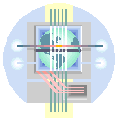
Instructional Materials for Craig White's Literature Courses
Writing More while maintaining quality |
 |
Higher education especially in Literature and the Humanities requires students to produce minimal lengths in numbers of words, paragraphs, or pages.
Fulfilling such requirements can challenge students in two ways:
![]() attitudes
toward quantity of language
attitudes
toward quantity of language
![]() production
practices (how to write more while maintaining quality and efficiency)
production
practices (how to write more while maintaining quality and efficiency)
![]()
Challenges in attitudes toward quantity of language
"Brevity is the soul of wit," says a character in Shakespeare's Hamlet.
Everyday people appreciate efficiency in language—saying as much as possible in as few words as possible.
However, academic life exists somewhat outside everyday life, and its differing values may include a tolerance for more rather than less speech or writing, as long as quality is maintained.
Negative pop-culture examples: Church-goers complain about the length of a sermon. Students complain about how long a teacher lectures.
Positive pop-culture examples: Macho movie stars (action and cowboy genres) let their actions or demeanors or their coolness do their talking, or they reply to questions minimally. (Villains tend to be mouthy.) Popular entertainment and journalism assumes short attention spans, so deliver the goods fast.
Negative classroom examples: Middling students' essays don't meet minimal lengths. Challenged, they rationalize: "I said all I had to say, and I didn't want to waste your time or mine with a lot of padding."
> Implicit attitude: student doesn't enjoy academic reading and writing, regards them as pointless work, can't imagine learning anything from it, and stops as soon as possible. (In contrast, professors and advanced students find reading and learning and sharing learning is its own reward.)
Positive classroom examples: Better students submit work that isn't just better in quality—it has more quantity. The quantity is part of the quality, as the writer explores extra dimensions or questions raised by the subject matter and critical thinking.
> Implicit attitude: student enjoys thinking, learns by testing and developing thoughts, keeps developing the draft submission as long as possible, and would work on it some more if time permitted. Writing = thinking.
Incentive for changing attitude: Higher education trains longer attention spans.
You're expected to speak or write efficiently and not waste other people's time, but an advanced audience knows that short, simple answers aren't always enough. As long as you're writing purposefully, educated people can keep reading.
Writers explore backgrounds and consequences of ideas, and support or develop ideas with facts, examples, citations, quotations, logic, etc.
![]()
Production Practices (how to write more while maintaining quality and efficiency)
![]() Provide, develop and analyze examples
Provide, develop and analyze examples
Examples from experience, culture, history, or texts automatically create words just by introducing and describing.
Even more words develop by analyzing example in terms of lessons, consequences, integrity, connections to earlier and later points and examples, etc.
![]() Explain references, define terms, and develop
contexts.
Explain references, define terms, and develop
contexts.
Provide "working definitions" for important terms. Measure examples against your definition so that you learn more about your definition and the example.
Don't assume your reader already knows what you're talking about. Explain backgrounds, terms, names, while providing contexts. (Even if your professor does know what you're talking about, s/he wants to know if you know what you're talking about.
![]() Compare and contrast earlier & later examples
or other evidence
Compare and contrast earlier & later examples
or other evidence
Comparing and contrasting nearly always generates fresh material just by making you think of things together.
Relating materials to each other intellectual sparks.
![]() Review what you've written.
Review what you've written.
Going over what you've already written, you'll often think of what you left out. Add words to earlier parts instead of just tacking them on at the end.
As you read through a paragraph, feel the intellectual momentum you're creating and think where it leads. (If A, then B, etc.) Extend the paragraph another sentence or two, or connect ideas or examples in this paragraph to those in other paragraphs.
![]() Work with your audience.
Work with your audience.
When reviewing a part you want to develop better or more, ask yourself: What a reader would want to happen at that point.
What questions would a reader ask about what you've written so far?
What might happen next that would please a reader? Anticipate their thoughts? Meet their needs?
![]() Review texts or sources that
inform your essay.
Review texts or sources that
inform your essay.
Take your eyes off your paper and put them back on your notes, textbooks, other sources, etc.
What words or ideas appeal to you that you can use as part of your own expression?
![]() Take a break, return to what you've written with fresh
eyes.
Take a break, return to what you've written with fresh
eyes.
"Two heads are better than one." If you look at what you've written after some time passes, you often see it differently and think fresh thoughts.
